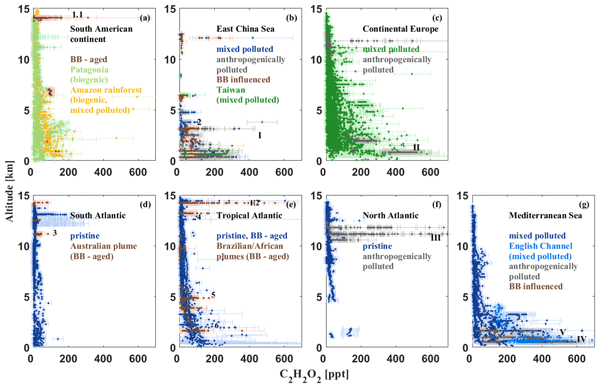New publication in Atmospheric Chemistry and Physics

The new publication by Flora Kluge et al. on “Airborne glyoxal measurements in the marine and continental atmosphere: comparison with TROPOMI observations and EMAC simulations” is now available in its final version in the EGU open access journal “Atmospheric Chemistry and Physics”. In this study measurements of glyoxal (C2H2O2) in the troposphere are compared to collocated glyoxal measurements of the TROPOspheric Monitoring Instrument (TROPOMI) and simulations from EMAC.
https://acp.copernicus.org/articles/23/1369/2023/
Abstract: We report on airborne limb and nadir measurements of vertical profiles and total vertical column densities (VCDs) of glyoxal (C2H2O2) in the troposphere, which were performed aboard the German research aircraft HALO (High Altitude and LOng Range) in different regions and seasons around the globe between 2014 and 2019. The airborne nadir and integrated limb profiles agree excellently among each other. Our airborne observations are further compared to collocated glyoxal measurements of the TROPOspheric Monitoring Instrument (TROPOMI), with good agreement between both data sets for glyoxal observations in (1) pristine terrestrial, (2) pristine marine, (3) mixed polluted, and (4) biomass-burning-affected air masses with high glyoxal concentrations. Exceptions to the overall good agreement are observations of (1) faint and aged biomass burning plumes over the oceans and (2) of low-lying biomass burning or anthropogenic plumes in the terrestrial or marine boundary layer, both of which contain elevated glyoxal that is mostly not captured by TROPOMI. These differences in airborne and satellite-detected glyoxal are most likely caused by the overall small contribution of plumes of a limited extent to the total glyoxal absorption in the atmosphere and the difficulty in remotely detecting weak absorbers located close to low reflective surfaces (e.g. the ocean in the visible wavelength range) or within dense aerosol layers. Observations of glyoxal in aged biomass burning plumes (e.g. observed over the tropical Atlantic off the coast of West Africa in summer 2018, off the coast of Brazil by the end of the dry season 2019, and the East China Sea in spring 2018) could be traced back to related wildfires, such as a plume crossing over the Drake Passage that originated from the Australian bushfires in late 2019. Our observations of glyoxal in such aged biomass burning plumes confirm recent findings of enhanced glyoxal and presumably secondary organic aerosol (SOA) formation in aged wildfire plumes from yet-to-be-identified, longer-lived organic precursor molecules (e.g. aromatics, acetylene, or aliphatic compounds) co-emitted in the fires. Furthermore, elevated glyoxal (median 44 ppt – parts per trillion), as compared to other marine regions (median 10–19 ppt), is observed in the boundary layer over the tropical oceans, which is well in agreement with previous reports. The airborne data sets are further compared to glyoxal simulations performed with the global atmosphere chemistry model EMAC (ECHAM/MESSy Atmospheric Chemistry). When using an EMAC set up that resembles recent EMAC studies focusing on complex chemistry, reasonable agreement is found for pristine air masses (e.g. the unperturbed free and upper troposphere), but a notable glyoxal overestimation of the model exists for regions with high emissions of glyoxal and glyoxal-producing volatile organic compounds (VOCs) from the biosphere (e.g. the Amazon). In all other investigated regions, the model underpredicts glyoxal to varying degrees, in particular when probing mixed emissions from anthropogenic activities (e.g. over continental Europe, the Mediterranean, and East China Sea) and potentially from the sea (e.g. the tropical oceans). Also, the model tends to largely underpredict glyoxal in city plumes and aged biomass burning plumes. The potential causes for these differences are likely to be multifaceted, but they all point to missing glyoxal sources from the degradation of the mixture of potentially longer-chained organic compounds emitted from anthropogenic activities, biomass burning, and from the organic microlayer of the sea surface.
© Author(s) 2023. This work is distributed under the Creative Commons Attribution 4.0 License.
Kluge, F., Hüneke, T., Lerot, C., Rosanka, S., Rotermund, M. K., Taraborrelli, D., Weyland, B., and Pfeilsticker, K.: Airborne glyoxal measurements in the marine and continental atmosphere: comparison with TROPOMI observations and EMAC simulations, Atmos. Chem. Phys., 23, 1369–1401, https://doi.org/10.5194/acp-23-1369-2023, 2023.
